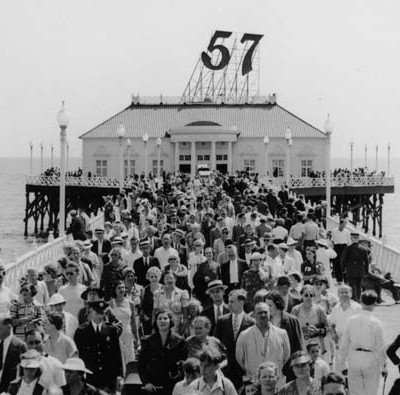
Atlantic City appears in the Jewish Criterion as early as 1895, when Jewish families, including the Gallingers, the Lehmans and the Rauhs, began noting it as a vacation destination in society page notices. Soon, the Hotel Isleworth was advertising its “Salt Baths. Open Grate Fires. Electric Lights.” Other hotels followed. By the turn of the century, the southern New Jersey coast was a premier destination for well-to-do families.
The Jewish community of Atlantic City was growing, too, making it a draw for national institutions. At a Jewish Chautauqua convention in Atlantic City in July 1902, Rabbi J. Leonard Levy of Rodef Shalom Congregation gave a well-received address on “Religious Aspects of the Immigrant Problem.” According to a report in the Pittsburgh Leader, “The large synagogue on Pennsylvania Avenue was not only crowded, but many clung to the doors and filled the steps, bending every muscle to catch the eloquent words spoken.”
By 1930, the growing middle class of Pittsburgh could also afford to spend summers in Atlantic City. As Jewish families left the crowded streets of the Hill District for homes in Squirrel Hill, Oakland and the East End, advertisements for Jewish-owned hotels such as The Breakers and Wildwood Manor in Atlantic City filled the Criterion. Many touted their “strictly kosher” kitchens and their Passover specials. The Pennsylvania Railroad marketed travel packages for those unable to make the arduous automobile trip across the state in the days before the Pennsylvania Turnpike. With so many Jewish families from Pittsburgh spending summers in Atlantic City, social surprises were inevitable: although Harry Shriber and Rose Levine lived near one another in the Hill District, they met for the first time in Atlantic City in the early 1930s and married in 1932.
Advertisements for Miami Beach hotels proliferated in the Jewish Criterion in the early 1950s, but Atlantic City remained a popular destination. Atlantic City vacation notices and advertisements began declining after the city legalized gambling in 1976.
The leisurely and familial nature of vacations always inspires photography. Atlantic City was particularly rich source of photographic material because roving photographers wandered the Boardwalk, snapping pictures for a fee. These photographs appear regularly in the family collections of the Rauh Jewish Archives, as seen below.